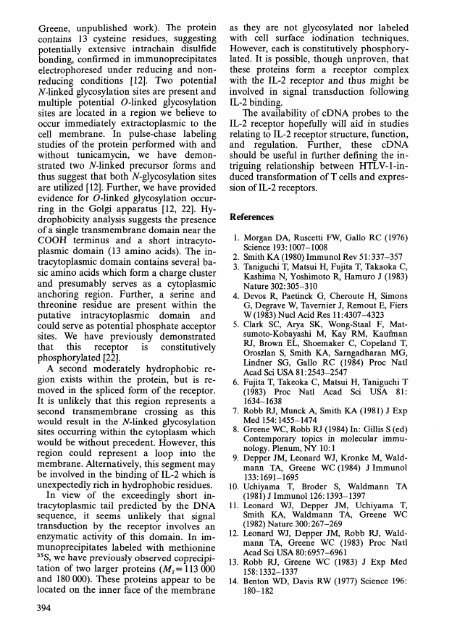Modern Trends in Human Leukemia VI - Blog Science Connections
Modern Trends in Human Leukemia VI - Blog Science Connections
Modern Trends in Human Leukemia VI - Blog Science Connections
Create successful ePaper yourself
Turn your PDF publications into a flip-book with our unique Google optimized e-Paper software.
Greene, unpublished work). The prote<strong>in</strong><br />
conta<strong>in</strong>s 13 cyste<strong>in</strong>e residues, suggest<strong>in</strong>g<br />
potentially extensive <strong>in</strong>tracha<strong>in</strong> disulfide<br />
bond<strong>in</strong>g, confirmed <strong>in</strong> immunoprecipitates<br />
electrophoresed under reduc<strong>in</strong>g and nonreduc<strong>in</strong>g<br />
conditions [12]. Two potential<br />
N-l<strong>in</strong>ked glycosylation sites are present and<br />
multiple potential O-l<strong>in</strong>ked glycosylation<br />
sites are located <strong>in</strong> a region we believe to<br />
occur immediately extractoplasmic to the<br />
cell membrane. In pulse-chase label<strong>in</strong>g<br />
studies of the prote<strong>in</strong> performed with and<br />
without tunicamyc<strong>in</strong>, we have demonstrated<br />
two N-l<strong>in</strong>ked precursor forms and<br />
thus suggest that both N-glycosylation sites<br />
are utilized [12]. Further, we have provided<br />
evidence for O-l<strong>in</strong>ked glycosylation occurr<strong>in</strong>g<br />
<strong>in</strong> the Golgi apparatus [12, 22]. Hydrophobicity<br />
analysis suggests the presence<br />
of a s<strong>in</strong>gle transmembrane doma<strong>in</strong> near the<br />
COOH term<strong>in</strong>us and a short <strong>in</strong>tracytoplasmic<br />
doma<strong>in</strong> (13 am<strong>in</strong>o acids). The <strong>in</strong>tracytoplasmic<br />
doma<strong>in</strong> conta<strong>in</strong>s several basic<br />
am<strong>in</strong>o acids which form a charge cluster<br />
and presumably serves as a cytoplasmic<br />
anchor<strong>in</strong>g region. Further, a ser<strong>in</strong>e and<br />
threon<strong>in</strong>e residue are present with<strong>in</strong> the<br />
putative <strong>in</strong>tracytoplasmic doma<strong>in</strong> and<br />
could serve as potential phosphate acceptor<br />
sites. We have previously demonstrated<br />
that this receptor IS constitutively<br />
phosphorylated [22].<br />
A second moderately hydrophobic region<br />
exists with<strong>in</strong> the prote<strong>in</strong>, but is removed<br />
<strong>in</strong> the spliced form of the receptor.<br />
It is unlikely that this region represents a<br />
second transmembrane cross<strong>in</strong>g as this<br />
would result <strong>in</strong> the N-l<strong>in</strong>ked glycosylation<br />
sites occurr<strong>in</strong>g with<strong>in</strong> the cytoplasm which<br />
would be without precedent. However, this<br />
region could represent a loop <strong>in</strong>to the<br />
membrane. Alternatively, this segment may<br />
be <strong>in</strong>volved <strong>in</strong> the b<strong>in</strong>d<strong>in</strong>g of IL-2 which is<br />
unexpectedly rich <strong>in</strong> hydrophobic residues.<br />
In view of the exceed<strong>in</strong>gly short <strong>in</strong>tracytoplasmic<br />
tail predicted by the DNA<br />
sequence, it seems unlikely that signal<br />
transduction by the receptor <strong>in</strong>volves an<br />
enzymatic activity of this doma<strong>in</strong>. In immunoprecipitates<br />
labeled with methion<strong>in</strong>e<br />
35<br />
5, we have previously observed coprecipitation<br />
of two larger prote<strong>in</strong>s (M r = 113 000<br />
and 180000). These prote<strong>in</strong>s appear to be<br />
located on the <strong>in</strong>ner face of the membrane<br />
as they are not glycosylated nor labeled<br />
with cell surface iod<strong>in</strong>ation techniques.<br />
However, each is constitutively phosphorylated.<br />
It is possible, though unproven, that<br />
these prote<strong>in</strong>s form a receptor complex<br />
with the IL-2 receptor and thus might be<br />
<strong>in</strong>volved <strong>in</strong> signal transduction follow<strong>in</strong>g<br />
IL-2 b<strong>in</strong>d<strong>in</strong>g.<br />
The availability of cDNA probes to the<br />
IL-2 receptor hopefully will aid <strong>in</strong> studies<br />
relat<strong>in</strong>g to IL-2 receptor structure, function,<br />
and regulation. Further, these cDNA<br />
should be useful <strong>in</strong> further def<strong>in</strong><strong>in</strong>g the <strong>in</strong>trigu<strong>in</strong>g<br />
relationship between HTLV-I-<strong>in</strong>duced<br />
transformation of T cells and expression<br />
ofIL-2 receptors.<br />
References<br />
1. Morgan DA, Ruscetti FW, Gallo RC (1976)<br />
<strong>Science</strong> 193: 1007-1008<br />
2. Smith KA (1980) Immunol Rev 51:337-357<br />
3. Taniguchi T, Matsui H, Fujita T, Takaoka C,<br />
Kashima N, Yoshimoto R, Hamuro J (1983)<br />
Nature 302:305-310<br />
4. Devos R, Paet<strong>in</strong>ck G, Cheroute H, Simons<br />
G, Degrave W, Tavernier J, Remout E, Fiers<br />
W (1983) Nuc1 Acid Res 11: 4307 -4323<br />
5. Clark SC, Arya SK, Wong-Staal F, Matsumoto-Kobayashi<br />
M, Kay RM, Kaufman<br />
RJ, Brown EL, Shoemaker C, Copeland T,<br />
Oroszlan S, Smith KA, Sarngadharan MG,<br />
L<strong>in</strong>dner SG, Gallo RC (1984) Proc Nat!<br />
Acad Sci USA 81:2543-2547<br />
6. Fujita T, Takeoka C, Matsui H, Taniguchi T<br />
(1983) Proc Natl Acad Sci USA 81:<br />
1634-1638<br />
7. Robb RJ, Munck A, Smith KA (1981) J Exp<br />
Med 154: 1455-1474<br />
8. Greene WC, Robb RJ (1984) In: Gillis S (ed)<br />
Contemporary topics <strong>in</strong> molecular immunology.<br />
Plenum, NY 10: 1<br />
9. Depper JM, Leonard WJ, Kronke M, Waldmann<br />
TA, Greene WC (1984) J Immunol<br />
133: 1691-1695<br />
10. Uchiyama T, Broder S, Waldmann TA<br />
(1981) J Immunol126: 1393-1397<br />
11. Leonard WJ, Depper JM, Uchiyama T,<br />
Smith KA, Waldmann TA, Greene WC<br />
(1982) Nature 300:267-269<br />
12. Leonard WJ, Depper JM, Robb RJ, Waldmann<br />
TA, Greene WC (1983) Proc Nat!<br />
Acad Sci USA 80:6957-6961<br />
13. Robb RJ, Greene WC (1983) J Exp Med<br />
158: 1332-1337<br />
14. Benton WD, Davis RW (1977) <strong>Science</strong> 196:<br />
180-182<br />
394
















